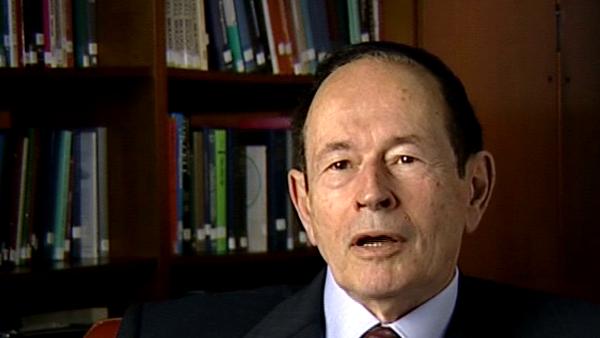NEXT STORY

Theorizing on the problem of how antibodies became different
RELATED STORIES

NEXT STORY

Theorizing on the problem of how antibodies became different
RELATED STORIES


|
Views | Duration | |
|---|---|---|---|
| 21. A visit from Leo Szilard | 640 | 01:01 | |
| 22. Completing work on the structure of gamma globulin molecule | 395 | 02:48 | |
| 23. Building a model of gamma globulin | 438 | 02:41 | |
| 24. Theorizing on the problem of how antibodies became different | 310 | 01:07 | |
| 25. Somatic recombination theory | 402 | 03:05 | |
| 26. Open and closed science | 449 | 01:50 | |
| 27. Into the field of embryogenesis and morphogenesis | 369 | 05:08 | |
| 28. Our laboratory as a chicken farm | 1 | 321 | 02:35 |
| 29. 'In my end is my beginning': Back to antibodies | 316 | 01:18 | |
| 30. The morphoregulator theory | 464 | 02:20 |


I can tell you one other epiphany. Having the business of the cleavage is one sort of... minor... The one of the Bence Jones protein is pretty impressive. The third one, which came with the help of my fellow scientists, was: when we had the whole structure, I disappeared in a room with some poppit beads, child's beads that... these little round plastic beads that hook into each other to make a chain, and some piano wire, and a frame you use usually to erect organic chemical reaction – sort of like the thing supporting the lights here – and after about two days, and my colleagues thought I was nuts, I had built a chain model of the antibody molecule. And of course it wasn't like what you really see when they finally did the X-ray but it was enough to do something really very satisfying, and I have to speak to that... sometimes you're lucky when you mean actually... put luck it... not important, just about four thirds. What was lucky was that the antibody problem was so severely constrained that once you saw that Macfarlane Burnet's theory was correct, and once you saw the structure, you could answer a huge number of questions that people were never able to answer. For example: what part of the molecule bound to the antigen?
Well, here Porter did something very remarkable because he cleaved the molecule by cutting the chains – instead of breaking the disulphide bonds he broke the chains themselves – and he got one part that bound the antigen and another part that happened to crystallize, that is in fact, we showed, responsible for the other functions of antibodies. So in short order what we got was a picture of a molecule that had these domains that had variable domains in the light and heavy chains, where the sequence changed, and which was accounting for why each myeloma protein antibody was different from the other, and constant domains, and we could actually... I think it was really one of the first proteins if not the first where domain structure was shown. And I'll come back to that because it's an important genetic problem, and you as a geneticist would realize this. Well, we could then assign to each domain a particular function, and then we could even hook the molecule and see how it was hooked up to the cell, and you'll remember that it was one cell, one antibody, and that if... and this generated the next question... if each antibody was different, how did they become different. Well, it turned out that here was a problem that Joe Gally and I worked on theoretically.
US biologist Gerald Edelman (1929-2014) successfully constructed a precise model of an antibody, a protein used by the body to neutralise harmful bacteria or viruses and it was this work that won him the Nobel Prize in Physiology or Medicine in 1972 jointly with Rodney R Porter. He then turned his attention to neuroscience, focusing on neural Darwinism, an influential theory of brain function.
Title: Building a model of gamma globulin
Listeners: Ralph J. Greenspan
Dr. Greenspan has worked on the genetic and neurobiological basis of behavior in fruit flies (Drosophila melanogaster) almost since the inception of the field, studying with one of its founders, Jeffery Hall, at Brandeis University in Massachusetts, where he received his Ph.D. in biology in 1979. He subsequently taught and conducted research at Princeton University and New York University where he ran the W.M. Keck Laboratory of Molecular Neurobiology, relocating to San Diego in 1997 to become a Senior Fellow in Experimental Neurobiology at The Neurosciences Institute. Dr. Greenspan’s research accomplishments include studies of physiological and behavioral consequences of mutations in a neurotransmitter system affecting one of the brain's principal chemical signals, studies making highly localized genetic alterations in the nervous system to alter behavior, molecular identification of genes causing naturally occurring variation in behavior, and the demonstration that the fly has sleep-like and attention-like behavior similar to that of mammals. Dr. Greenspan has been awarded fellowships from the Helen Hay Whitney Foundation, the Searle Scholars Program, the McKnight Foundation, the Sloan Foundation and the Klingenstein Foundation. In addition to authoring research papers in journals such as "Science", "Nature", "Cell", "Neuron", and "Current Biology", he is also author of an article on the subject of genes and behavior for "Scientific American" and several books, including "Genetic Neurobiology" with Jeffrey Hall and William Harris, "Flexibility and Constraint in Behavioral Systems" with C.P. Kyriacou, and "Fly Pushing: The Theory and Practice of Drosophila Genetics", which has become a standard work in all fruit fly laboratories.
Tags: Rodney Porter, Macfarlane Burnet, Joe Gally
Duration: 2 minutes, 41 seconds
Date story recorded: July 2005
Date story went live: 24 January 2008